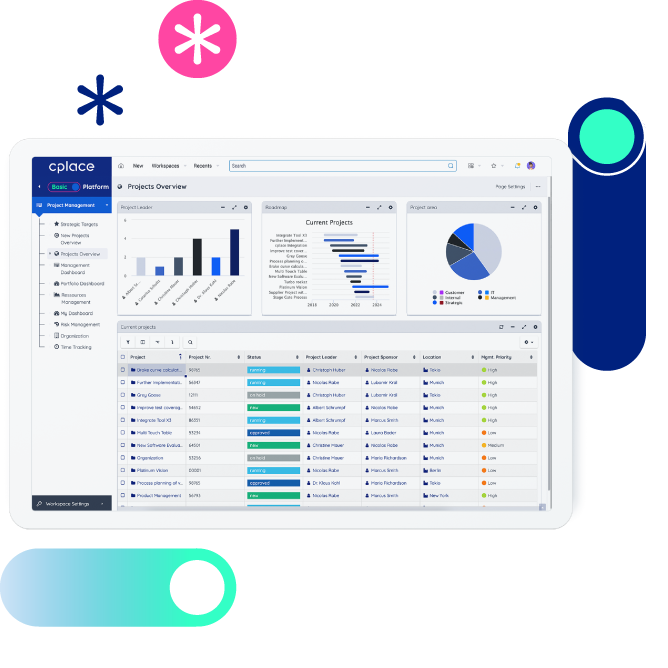Milestones in Project Management

What is a Milestone?
A milestone is a significant point or stage in a project or process. Milestones are used to measure progress, monitor success and structure the schedule. They are often defined by specific events, outcomes or deadlines that must be achieved to ensure that the project progresses successfully. Milestones can be, for example, the completion of an important part of a project, the achievement of a certain production quantity, the fulfillment of certain requirements or the meeting of intermediate deadlines. They help project teams keep track of progress and ensure that everyone involved stays on track.
Where does the term “Milestone” come from?
The term “Milestone” originally comes from the time of Roman antiquity. More precisely: the construction of roads. The Romans built an extensive network of roads that criss-crossed their empire. Along these roads, stones or pillars were regularly placed a mile apart. These milestones served as landmarks for travelers to measure the distances between cities and important places. They were not only useful for navigation, but also for the management and safety of the road network.
In a figurative sense, the term “milestone” was later applied to other areas to mark significant stages or events. Today, the term is used in various contexts to mark important progress or achievements in projects, programs or even stages of life.
What is a milestone in agile project management?
The interplay between milestones and agile project management plays a role in hybrid projects in particular. Traditional milestone planning is used to safeguard the project: at a milestone, the status quo of the project is checked according to a target defined in the milestone: the specified milestone targets must be achieved before the project is continued.
These milestones are also binding for areas that do not work according to traditional project management methods. Agile methods that are not based on fixed schedules must incorporate the individual milestone specifications into their agile planning in order to fulfill the purpose of the milestone, which is to check the project status. It can be discussed on a case-by-case basis whether specific goals defined in the milestone can be achieved by agile teams at a later date.
In some cases, the function of milestones is integrated into agile methods, for example in the form of Iteration and Sprint milestones or product milestones.
How many milestones does a project have?
The number of milestones in a project can vary greatly and depends on various factors, including the size, complexity and duration of the project as well as the specific requirements and objectives. There is no hard and fast rule as to how many milestones a project should have.
Some projects may have only a few milestones that mark important stages or completions, while other projects may have been planned with many milestones that detail different aspects and phases of the project. The number of milestones varies depending on the project management method.
However, as a general rule, milestones should be defined to mark significant progress, completions or decision points in the project. It is important to plan the number of milestones so that you can effectively monitor the progress of the project and ensure that the project is on track.
How do I formulate a milestone?
Formulating a milestone in project management requires clarity, precision and a clear link to the objectives of the project. By formulating and defining milestones, teams can effectively track the progress of the project and ensure that the project does not run off track. The following steps can help with a design:
- Identify the purpose of the milestone: Why is this milestone important? What significance does it have for the overall project? A milestone should mark significant progress, completion or a critical decision in the project.
- Name the milestone: A meaningful name should clearly describe the purpose and significance of the milestone. Clear, concise names are suitable for this.
- Describe the milestone criteria: Specific criteria can be defined here. If these are met, the milestone is considered achieved. These criteria should be measurable, clear and objective in order to avoid misunderstandings.
- Set a time frame: Determining when each milestone should be achieved helps to plan and track the progress of the project.
- Communicate the milestone: The milestone should be known to all relevant stakeholders. The importance and expectations regarding the achievement of the milestone are clearly communicated.
Example of how to formulate a milestone
- Name of the milestone: Completion of the design phase.
- Description: All website user interface designs have been finalized and approved by stakeholders. All required changes have been implemented and the final design has been released for implementation.
- Milestone criteria: All mockups have been created and approved. All UI/UX components have been finalized and approved. All adjustments based on stakeholder feedback have been made.
- Date: March 12, 2025

Advantages and disadvantages of project planning with milestones
Milestones can be a valuable planning method to track the progress of projects and ensure their positive development. However, it is important to carefully weigh the pros and cons and make milestone planning flexible and adaptable to promote the success of the project.
Advantages of milestones in project planning
- Progress measurement:
Milestones make it possible to clearly track the progress of the project. They serve as reference points to check whether the project is on schedule and whether the goals are being achieved. - Clear goal setting:
Setting milestones helps to define clear stage objectives for the project and focus on key stages or deliverables.
- Communication and transparency:
Milestones provide a clear communication basis for everyone involved in the project. They help to make the progress of the project transparent and enable effective collaboration. - Identification of bottlenecks:
By planning milestones, obstacles in the project can be identified relatively early on. This makes it possible to take measures in good time to correct or adjust the course of the project.
Disadvantages of milestones in project planning
- Rigidity: Setting milestones too rigidly can cause the project to become inflexible and create difficulties in adapting to changing requirements or circumstances.
- Lack of flexibility: If milestones are too detailed and numerous, this can lead to a lack of flexibility. Teams may become too focused on meeting milestones and lose sight of the true value of the project.
- Lack of consideration of uncertainty: Milestone planning is often based on assumptions about how the project will progress. If these assumptions turn out to be wrong or unforeseen problems arise, milestones can be missed and delays can occur.
- Overemphasis on timescales: Milestone planning often emphasizes the time dimension of the project. As a result, there is a risk that the other two points of the magic triangle of project management, quality or budget, are neglected.
Why are milestones important for a project?
Milestones are an important tool in project management to monitor the progress of the project, manage schedules, set goals and facilitate communication between project stakeholders. They help to ensure the success of the project and keep everyone involved on the same page. The breakdown into tangible milestones to be achieved also strengthens the motivation and stamina of those involved in the project.
Presentation of milestones
cplace offers a variety of project management solutions specifically designed for managing projects and milestones. These solutions allow milestones to be created and managed as separate entries, often containing additional information such as descriptions, due dates and responsibilities.
- Gantt Charts:
Gantt Charts are a frequently used method for visualizing milestones in projects. In a Gantt Chart, tasks and milestones are visualized on a timeline, with the milestones often identified as special markers or symbols.
- Kanban Boards:
Kanban Boards are an instrument of agile project management methods in which tasks are displayed on a virtual board that is divided into columns. Milestones can be displayed as separate cards on the board to mark important stages in the project. - Roadmaps:
Roadmaps are visual representations of project goals and milestones over a period of time. These can take various forms such as timelines or graphs that show the progress and dependencies between different milestones.
